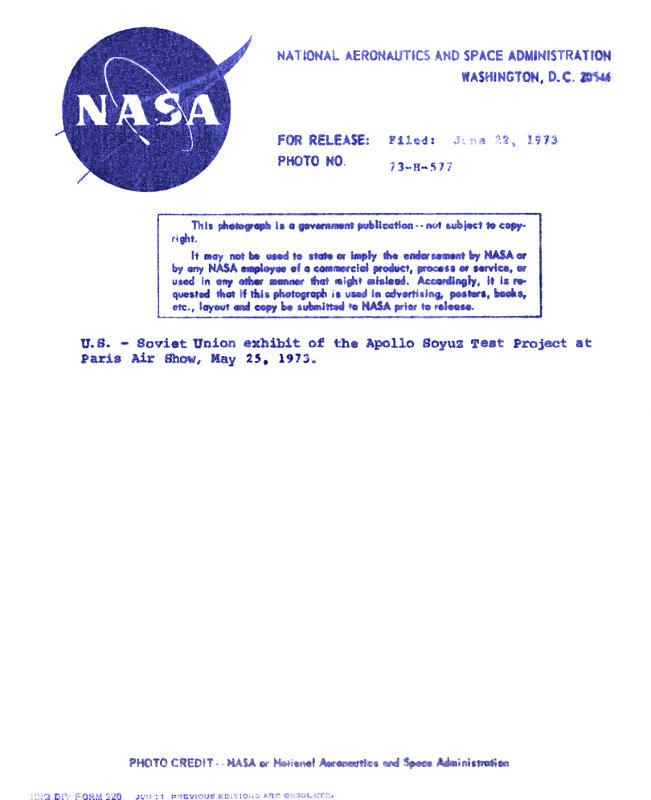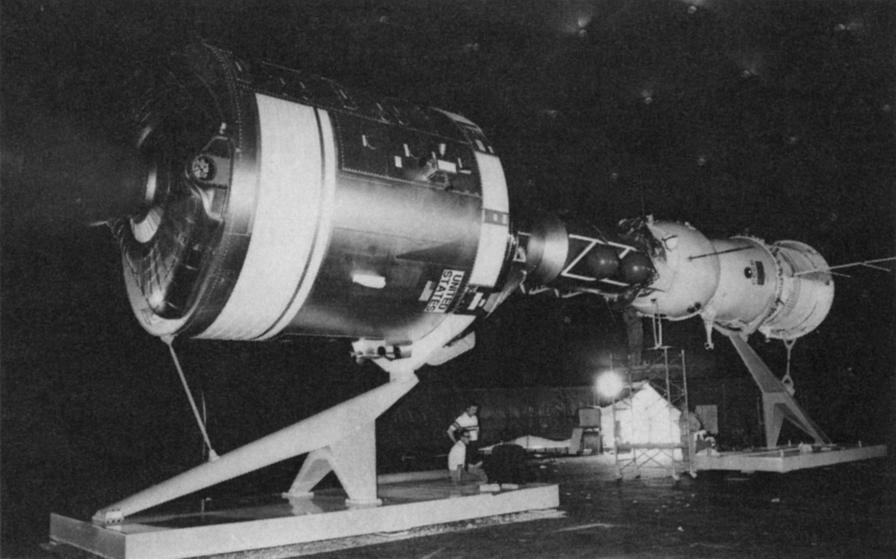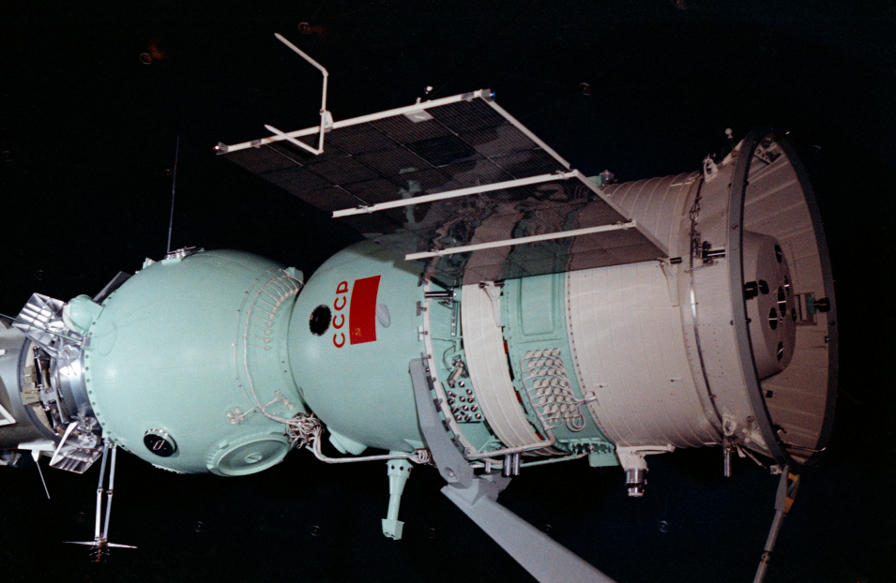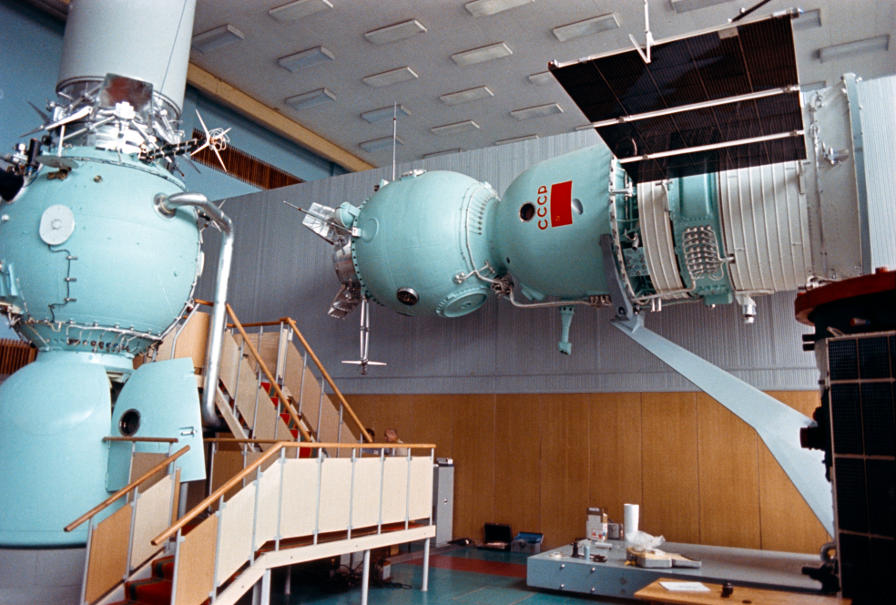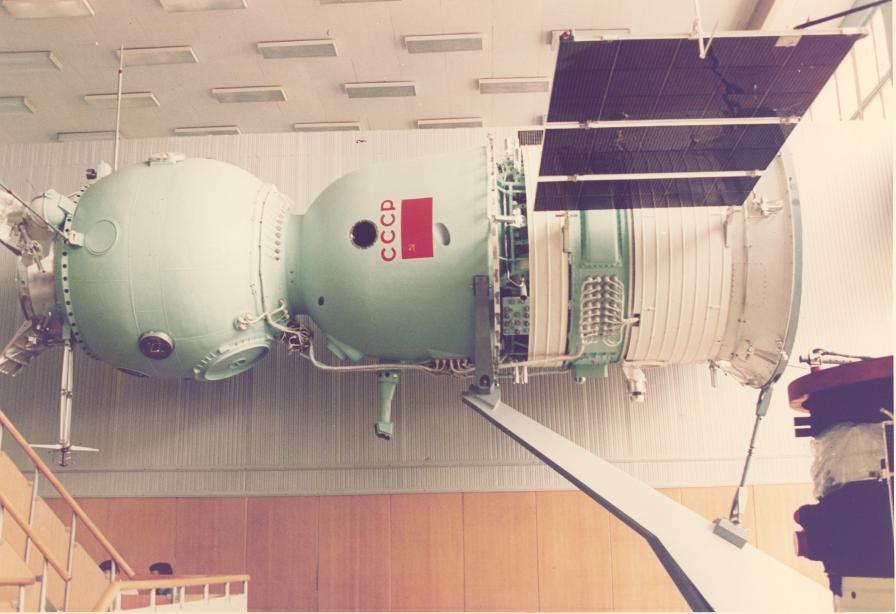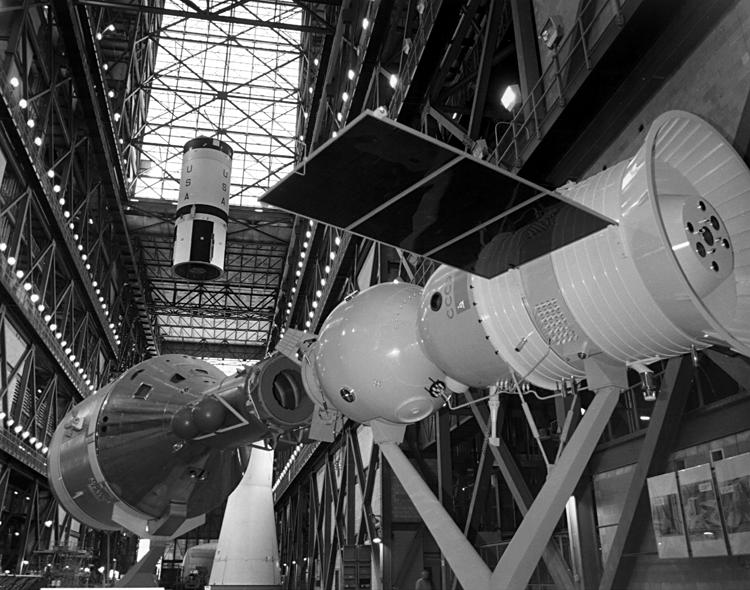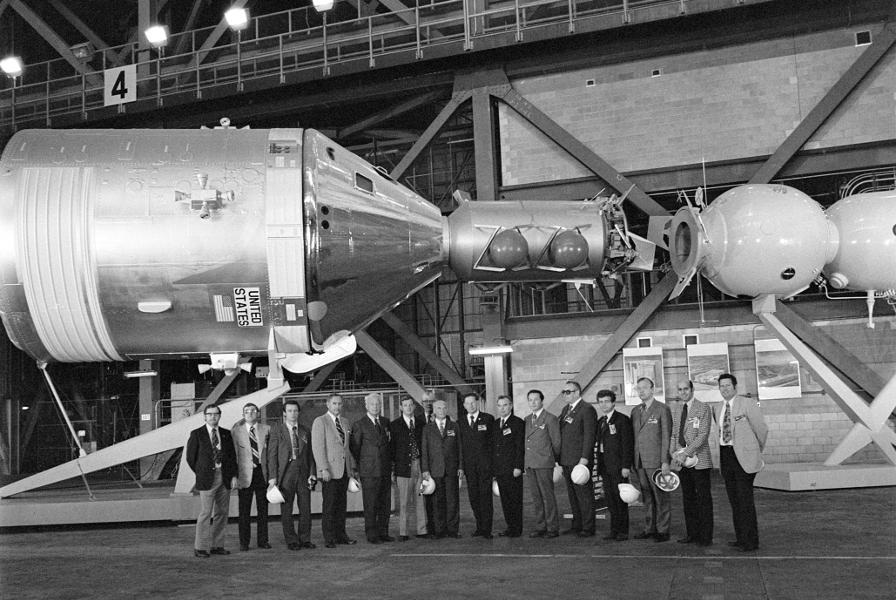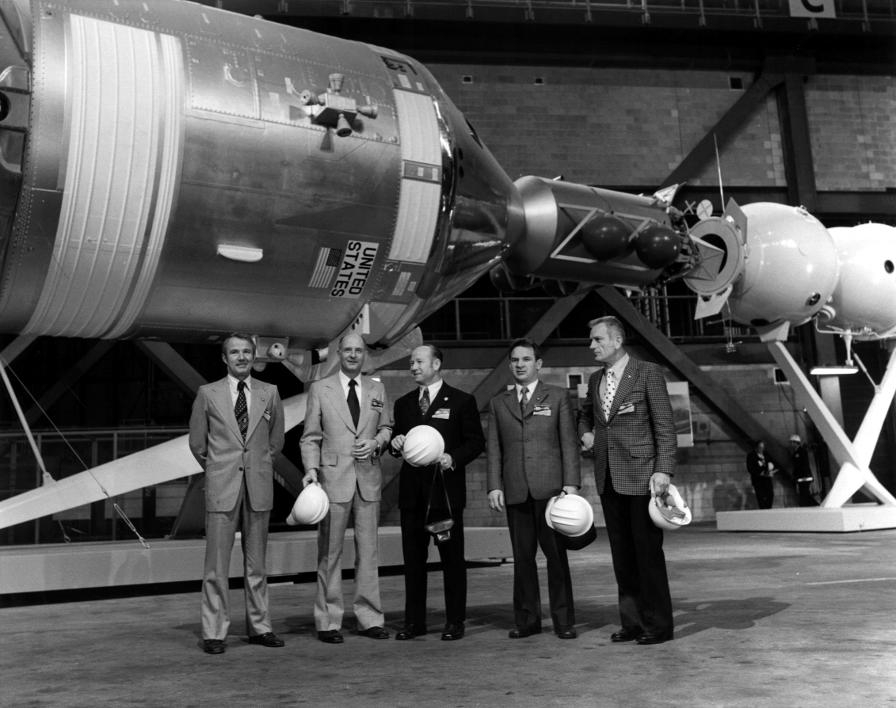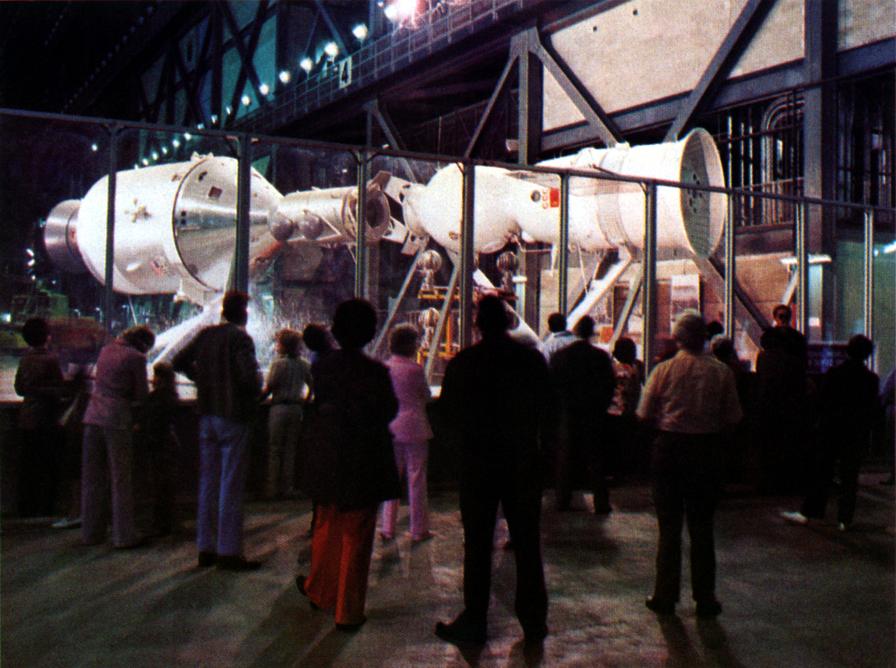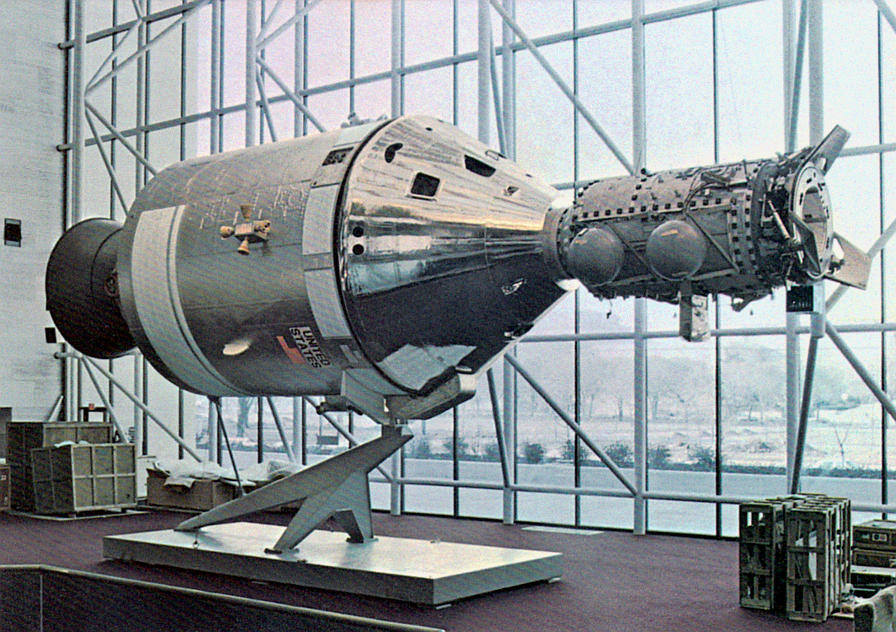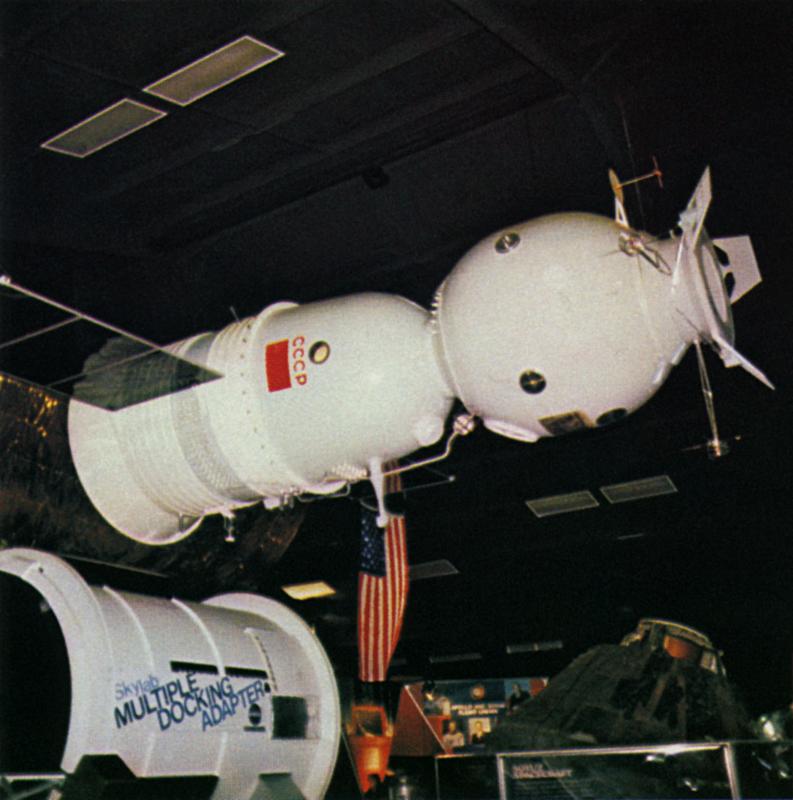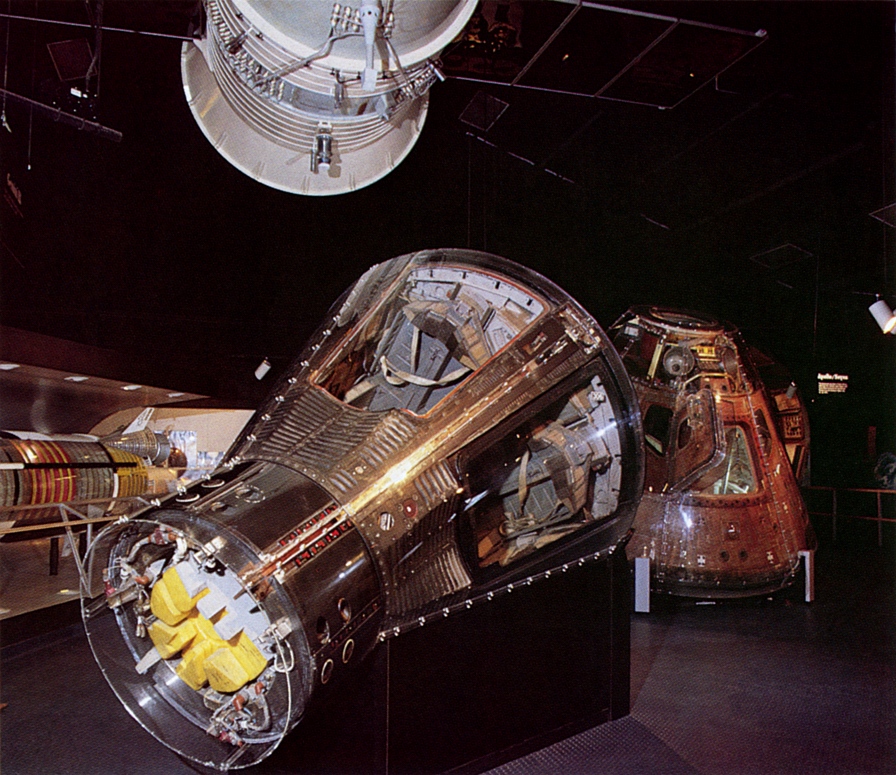Apollo-Soyuz Test Project Display at the National Air & Space Museum
A major exhibit at the National Air & Space Museum is the Apollo-Soyuz Test Project (ASTP) display. NASM opened on July 1, 1976, and with the ASTP mission having been completed a scant eleven months earlier (splashdown of the Apollo command module on July 24, 1976), the ASTP display must have been a big draw at the museum's opening. However, the National Air and Space Museum was not the first place where such a display had been exhibited.
The Apollo-Soyuz Test Project was probably as much about the politics of international cooperation as it was about the technical aspects of joint spaceflight or scientific investigation, so both the U.S. and U.S.S.R. worked together to provide positive publicity. Joint press kits and "design characteristics" documents were produced, in both English and Russian, which included drawings and technical diagrams with captions in both languages. But perhaps the most visually impressive display of international cooperation was a display of international hardware at the 1973 Paris Air Show (also known as "the Salon," after "Salon international de l'aéronautique et de l'espace, Paris-Le Bourget," the French name for the show), which ran from May 24 to June 3 of that year.
At the time, Flightglobal magazine reported, "International collaboration is a feature of every exhibit concerned with spaceflight at this year's Salon." The highlight was the Apollo-Soyuz Test Project display, featuring an Apollo command/service module docked (via a docking module mockup) with a Soyuz spacecraft, housed in a special pavilion near the show's entrance. The Soviet ASTP crew was announced on May 24, to coincide with the opening of the air show, and Alexei Leonov (commander of the prime Soyuz crew), Anatoly Filipchenko (commander of the backup Soyuz crew), and Tom Stafford (commander of the Apollo spacecraft) took part in a brief unveiling ceremony on the show's opening day (the American contingent was smaller than planned as many astronauts were involved in the effort to save the Skylab Orbital Workshop, which had suffered a structural failure during launch on May 14).
NASA issued a photo of the conjoined spacecraft as they appeared at the Paris Air show:
NASA Photo 73-H-577.
Click image for a 1202x855 pixel version of this image in a new window.
From an eBay auction listing.
Cleanup by heroicrelics.
Reverse of NASA Photo 73-H-577.
Click image for a 810x995 pixel version of this image in a new window.
From an eBay auction listing.
Reconstruction by heroicrelics.
The photo's caption reads
For Release: Filed: June 22, 1973
Photo No. 73-H-577U.S. - Soviet Union exhibit of the Apollo Soyuz Test Project at Paris Air Show, May 25, 1972.
A similar photo depicts the display prior to the show's opening, with workmen resting on the display. It took the workers five days to prepare and dock the two spacecraft in the Paris Air Show display, and a NASA manager quipped that he hoped the actual crews would get the job done a lot faster when they met in orbit:
Click image for a 2070x1292 pixel version of this image in a new window.
From page 250 of SP-4209 The Partnership: A History of the Apollo-Soyuz
Test Project, also available in
electronic format.
Scan and cleanup by heroicrelics.
The Apollo command/service module used in the display was a production CSM, spacecraft 105 which had been used in vibration and acoustic tests at the Manned Spacecraft Center (subsequently renamed the Johnson Space Center) to demonstrate the structural integrity of the CSM wiring, plumbing, and installed subsystems when subjected to dynamic loads from exposure to the aerodynamic noise and low-frequency vibrations of atmospheric flight. Numerically, CSM-105 came between Apollo 9 (CSM-104) and Apollo 10 (CSM-106), but it was not destined for flight.
CSM-105 is the spacecraft currently on display at the National Air & Space Museum and is NASM catalog #A19740798000.
NASA apparently thought that the sight of the Soyuz spacecraft in the Paris Air Show display was sufficiently novel that it issued a photo of just the Soyuz:
NASA photo S73-27666.
Click image for additional information about this image at NASA's Human
Spaceflight Gallery in a new window.
The origin of this Soyuz spacecraft is less certain, with most sources simply saying something to the effect of "assembled from left-over test hardware." After the Paris Air Show, the mockup spacecraft was for a time placed on display at the cosmonaut training center at Star City:
NASA photo S74-24675.
Click image for additional information about this image at NASA's Human
Spaceflight Gallery in a new window.
NASA photo S74-26395.
Click image for additional information about this image in the Great Images in
NASA collection at archive.org in a new window.
This appears to be the same spacecraft mockup as is currently in NASM's ASTP display; if not, the two mockups are similarly detailed. Although I've seen a number of photos of similarly-detailed Soyuz mockups on the same sort of display stand, since the ASTP docking mechanism is different than that installed on regular Soyuz spacecraft, it would seem that there would have been relatively few such mockups produced. However, there does appear to be at least one other, similar Soyuz mockup which was exhibited in an ASTP display in the Park of Economic Achievement in Moscow (two photos near the bottom of the page). The CSM in this display is listed by the Field Guide to American Spacecraft as CSM-098, a Block I spacecraft which used in the 2TV-1 and 2TV-2 Apollo vacuum chamber ground tests in the Space Environment Simulation Laboratory at the Manned Spacecraft Center.
I was heartened when I saw that two different photos of the same spacecraft were slightly different colors: Depending upon the lighting conditions, the photos I took of the Soyuz mockup at NASM range from pale blue to minty green. Since vintage film photos also show this variation, it's less likely to be a problem with the white balance on my camera.
The ASTP mockup made a return engagement in the Kennedy Space Center Vehicle Assembly Building (VAB) in 1975, although with a different, less-detailed Soyuz mockup:
NASA Photo KSC-75P-5.
Click image for additional information about this photo at the Apollo Soyuz
Test Project Image Gallery in a new window.
NASA photo S75-24026.
Click image for additional information about this image at NASA's Human
Spaceflight Gallery in a new window.
NASA Photo KSC-75P-0037.
Click image for additional information about this photo at the Kennedy Space
Center Photo Archive in a new window.
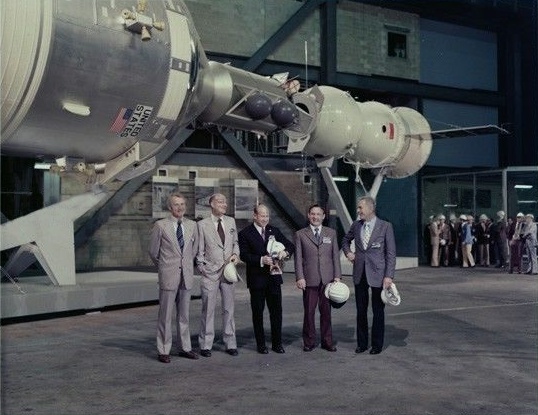
From an eBay auction listing.
Reconstruction by heroicrelics.
This Soyuz mockup is on a different type of support stand and is less detailed than the one from the Paris Air Show (note the lack of the recessed area aft of the Soviet flag, less detailed interface between the descent module and instrumentation/propulsion module, less detailed external wiring, and lack of weld seams). It also looks shiny, rather than the matte finish of the Soyuz mockup in the photos above. This Soyuz mockup looks very similar to the Soyuz model in the KSC Visitor Center's Early Space Exploration Building.
Although it looks in the black and white photos above that the Soyuz was some other color with white accents, it appears that it was actually off-white with white accents (this is more apparent in the other photos below):
Click image for a 2697x2012 pixel version of this image in a new window.
The ASTP mockup in the VAB on a KSC Visitor Information Center tour. From an
undated KSC souvenir booklet apparently issued some time after the return of
the final manned Skylab mission (February 1974) but prior to the ASTP launch
(July 1975).
Scan and cleanup by heroicrelics.
The next (and presumably final) appearance of the ASTP display occurred with the opening of the National Air & Space Museum in July 1976, for which it was reunited with the Soyuz mockup from the Paris Air Show (or another Soyuz mockup of similar detail). The low-fidelity docking module mockup(s) from the previous incarnations of the display was, at NASM, replaced with the ASTP flight backup docking module (the backup DM being reserved for possible use before the flight, but released for display after the ASTP mission completed).
Here is a photo of the CSM and DM having been installed in NASM's Space Race Gallery, prior to the installation of the Soyuz mockup:
Click image for a 1600x1129 pixel version of this image in a new window.
From an eBay auction listing.
Cleanup by heroicrelics.
The Soyuz mockup which was used in the VAB prior to the ASTP launch appears to have remained at the Kennedy Space Center, placed on display in the Visitor Information Center near the actual ASTP command module. Although this photo appears to have been taken with a powerful flash, the off-white-with-white-accents nature of the mockup's color is more apparent than the VAB photo above.
Click image for a 2234x2254 pixel version of this image in a new window.
Soyuz mockup in the KSC Visitor Information Center's Hall of History. From an
undated KSC souvenir booklet apparently issued some time between 1976 and
September 1979.
Scan and cleanup by heroicrelics.
Another photo showing part of the Soyuz mockup above Gemini 9, with the ASTP CSM in the background.
Click image for a 2536x2193 pixel version of this image in a new window.
Soyuz mockup in the KSC Visitor Information Center Gallery of Spaceflight.
From an undated KSC souvenir booklet apparently issued some time between August
1986 and December 1991.
Scan and cleanup by heroicrelics.
Of course, I'm not certain that this mockup is the same one as was in the VAB display, but their appearance is very similar. This mockup also looks very similar (other than the color) to the Soyuz mockup on display today at the KSC Visitor Complex.


